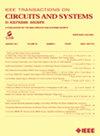Mamba-Unet-Depth:增强光子高效成像的远程依赖性
IF 4.9
2区 工程技术
Q2 ENGINEERING, ELECTRICAL & ELECTRONIC
IEEE Transactions on Circuits and Systems II: Express Briefs
Pub Date : 2025-06-18
DOI:10.1109/TCSII.2025.3580670
引用次数: 0
摘要
随着单光子激光雷达的快速发展,精确的深度恢复仍然是一个关键的挑战。传统的深度学习方法,如cnn和ViTs,分别利用卷积和自关注来提取局部和全局特征。然而,这些模型很难捕获深度图像中的长期依赖关系,特别是在低信背景比(SBR)条件下。为了解决这个问题,我们提出了Mamba- unet - depth,这是一种受Mamba结构启发的新型网络,它可以有效地模拟长序列和全局上下文。通过将U-Net的分层表示能力与Mamba的顺序建模能力相结合,该模型使用跳跃连接来保留跨尺度的空间细节,从而促进更丰富的特征学习。这使得在具有挑战性的激光雷达数据中更有效地提取细粒度和上下文深度线索。在NYU Depth v2数据集上的实验结果表明,Mamba-Unet-Depth在深度预测精度和鲁棒性方面优于现有基线,达到了最先进的性能。本文章由计算机程序翻译,如有差异,请以英文原文为准。
Mamba-Unet-Depth: Enhancing Long-Range Dependency for Photon-Efficient Imaging
With the rapid development of single-photon LiDAR, accurate depth recovery remains a key challenge. Conventional deep learning methods, such as CNNs and ViTs, leverage convolution and self-attention to extract local and global features, respectively. However, these models struggle to capture long-range dependencies in depth images, especially under low signal-to-background ratio (SBR) conditions. To address this, we propose Mamba-Unet-Depth, a novel network inspired by the Mamba architecture, which models long sequences and global context efficiently. By combining the hierarchical representation capability of U-Net with Mamba’s sequential modeling strength, the proposed model uses skip connections to retain spatial details across scales, facilitating richer feature learning. This enables more effective extraction of both fine-grained and contextual depth cues in challenging LiDAR data. Experimental results on the NYU Depth v2 dataset show that Mamba-Unet-Depth outperforms existing baselines in depth prediction accuracy and robustness, achieving state-of-the-art performance.
求助全文
通过发布文献求助,成功后即可免费获取论文全文。
去求助
来源期刊
CiteScore
7.90
自引率
20.50%
发文量
883
审稿时长
3.0 months
期刊介绍:
TCAS II publishes brief papers in the field specified by the theory, analysis, design, and practical implementations of circuits, and the application of circuit techniques to systems and to signal processing. Included is the whole spectrum from basic scientific theory to industrial applications. The field of interest covered includes:
Circuits: Analog, Digital and Mixed Signal Circuits and Systems
Nonlinear Circuits and Systems, Integrated Sensors, MEMS and Systems on Chip, Nanoscale Circuits and Systems, Optoelectronic
Circuits and Systems, Power Electronics and Systems
Software for Analog-and-Logic Circuits and Systems
Control aspects of Circuits and Systems.

 求助内容:
求助内容: 应助结果提醒方式:
应助结果提醒方式:


